Abstract
OBJECTIVES: The purpose of this study was to determine the feasibility of implementing a diabetes prevention program (DPP) in a rural African-American church. METHODS: A six-session DPP, modeled after the successful National Institutes of Health (NIH) DPP, was implemented in a rural African-American church. Adult members of the church identified as high risk for diabetes, based on results of a risk questionnaire, were screened with a fasting glucose. Persons with prediabetes, a fasting glucose of 100-125 mg/dL, participated in the six-session, Lifestyle Balance Church DPP. The primary outcomes were attendance rates and changes in fasting glucose, weight and body mass index measured at baseline, six- and 12-month follow-up. RESULTS: Ninety-nine adult church members were screened for diabetes risk. Eleven had impaired fasting glucose. Ten of 11 participated in the six-session intervention, for an attendance rate of 78%. After the intervention and 12-month follow-up, there was a mean weight loss of 7.9 lbs and 10.6 lbs, respectively. CONCLUSIONS: This pilot project suggests that a modified six-session DPP can be translated to a group format and successfully implemented in a church setting. Further randomized studies are needed to determine the effectiveness of such an intervention.
Full text
PDF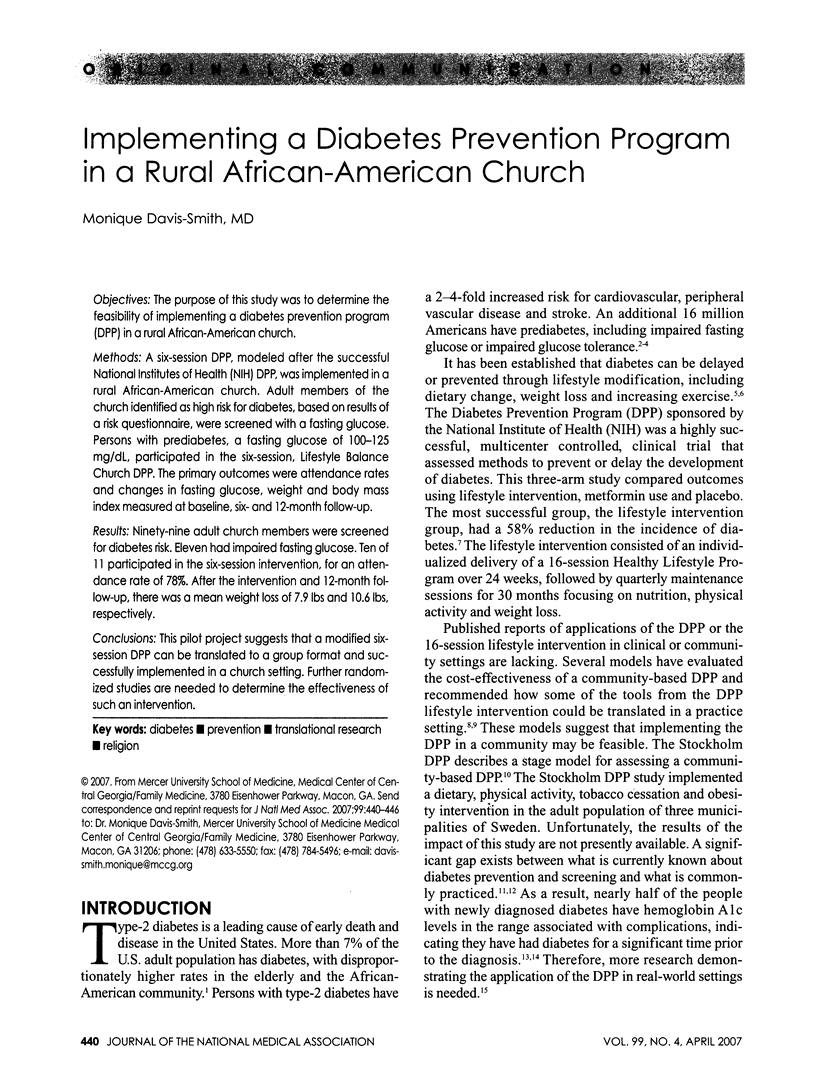
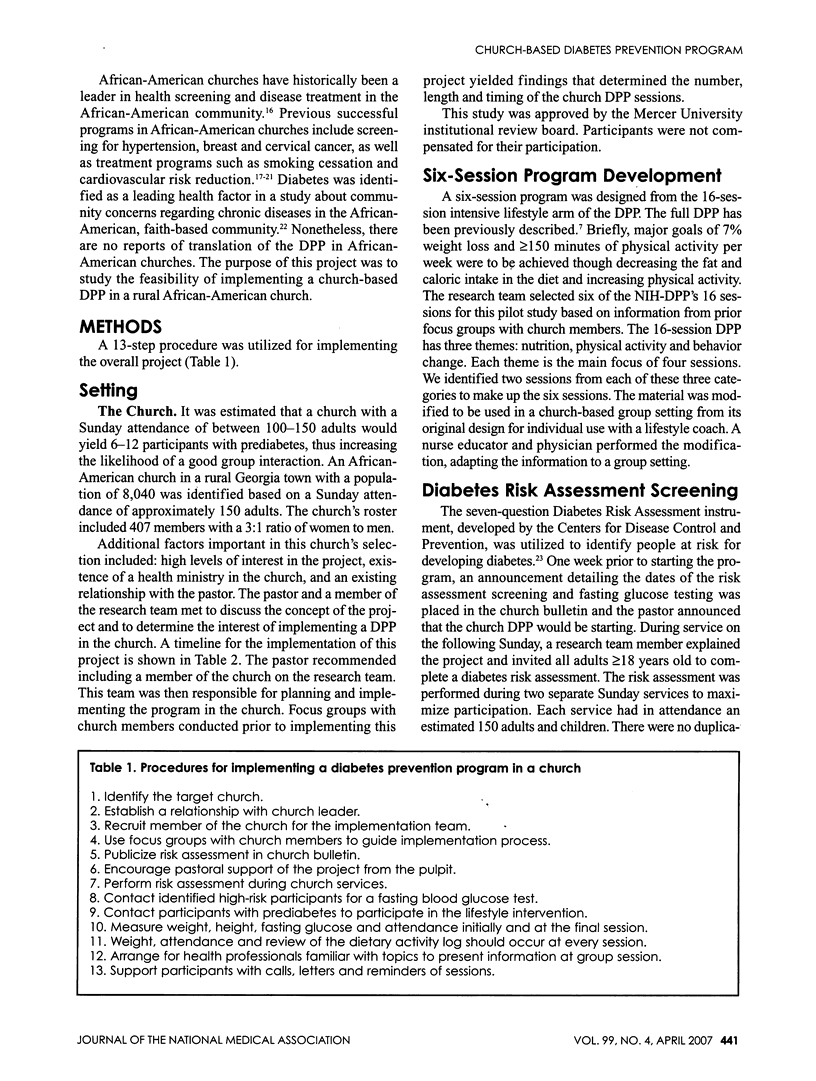
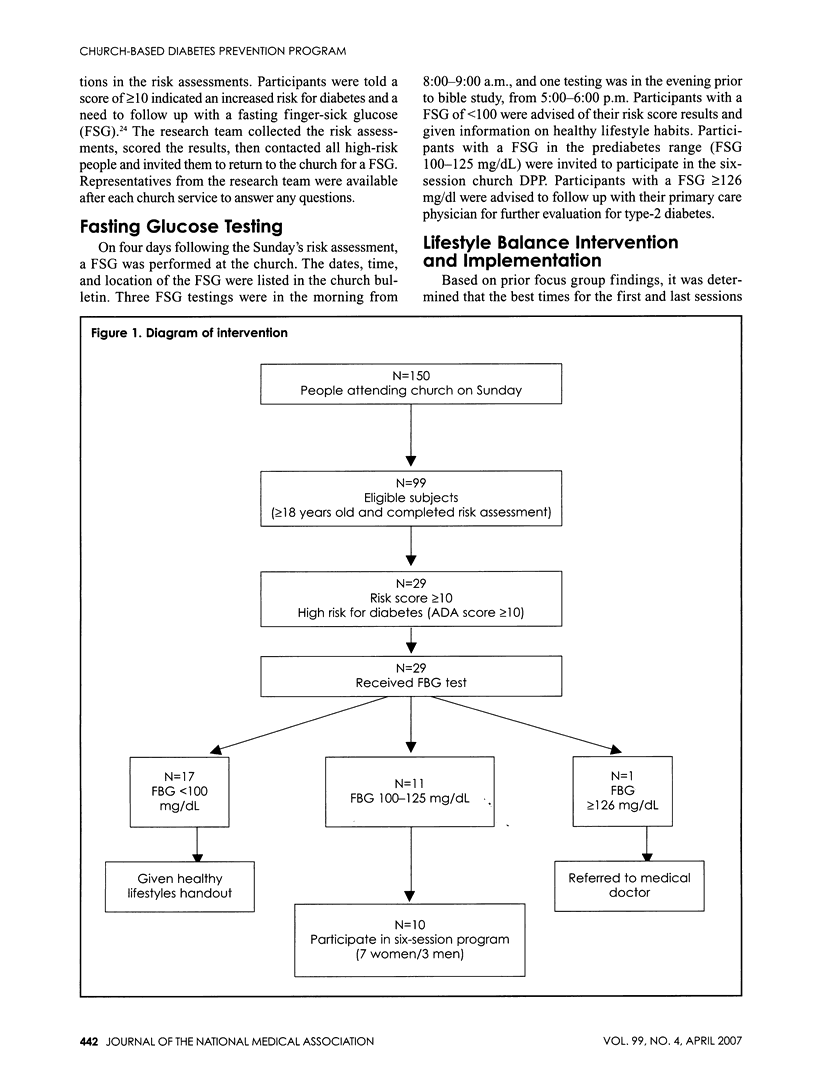
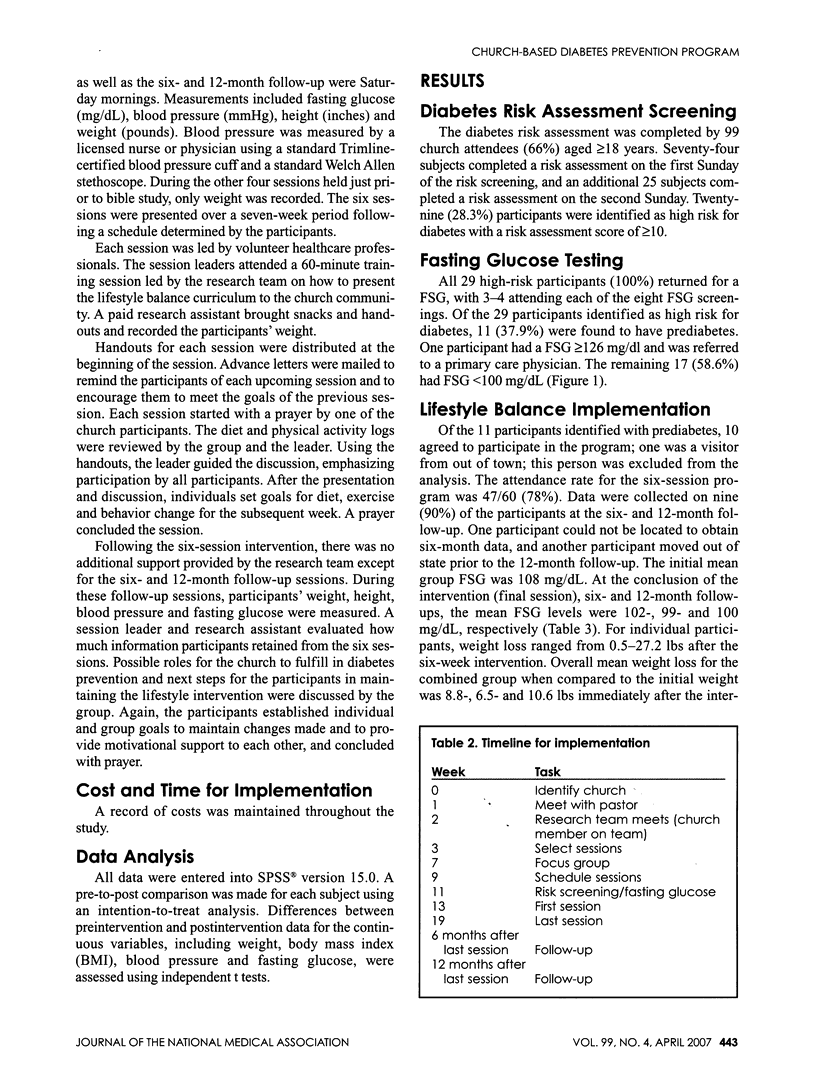
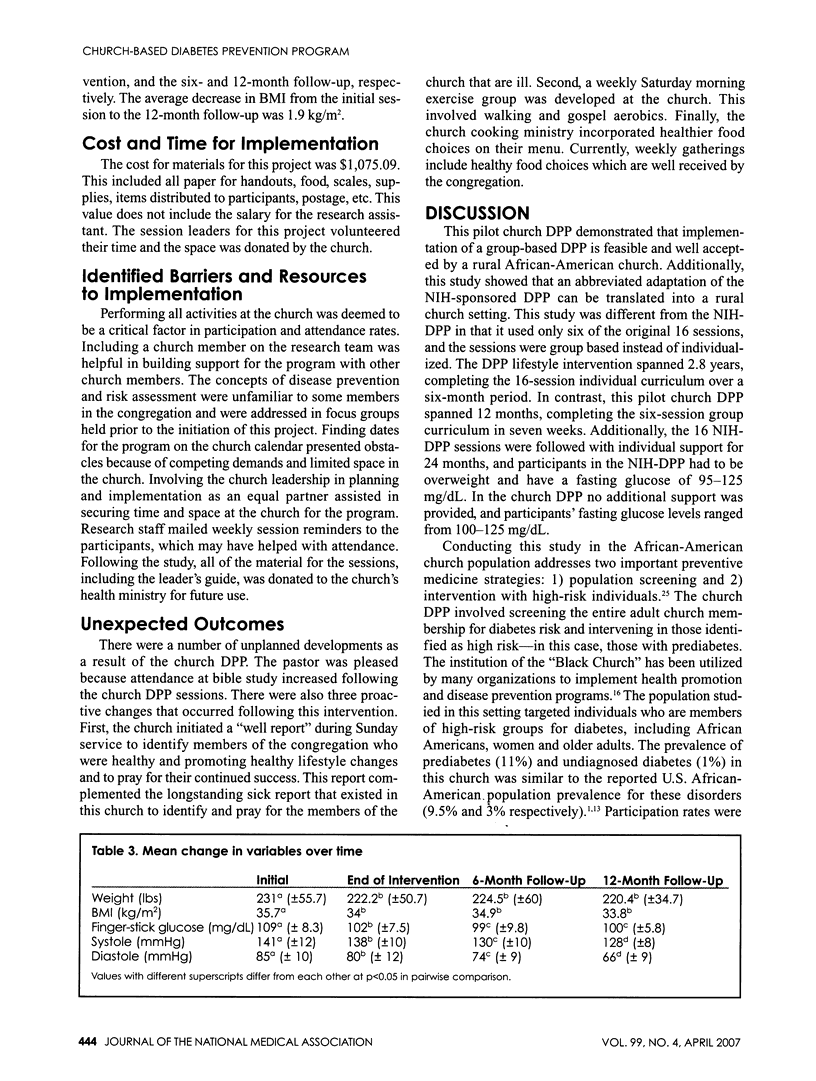
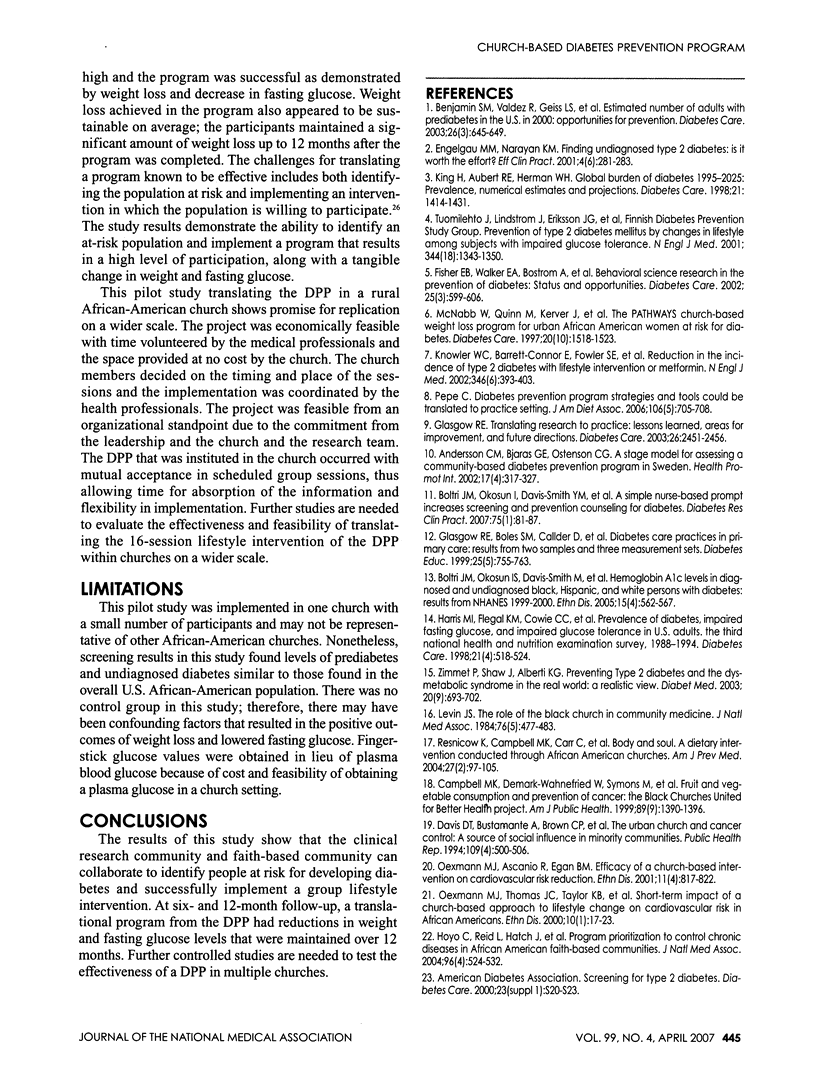
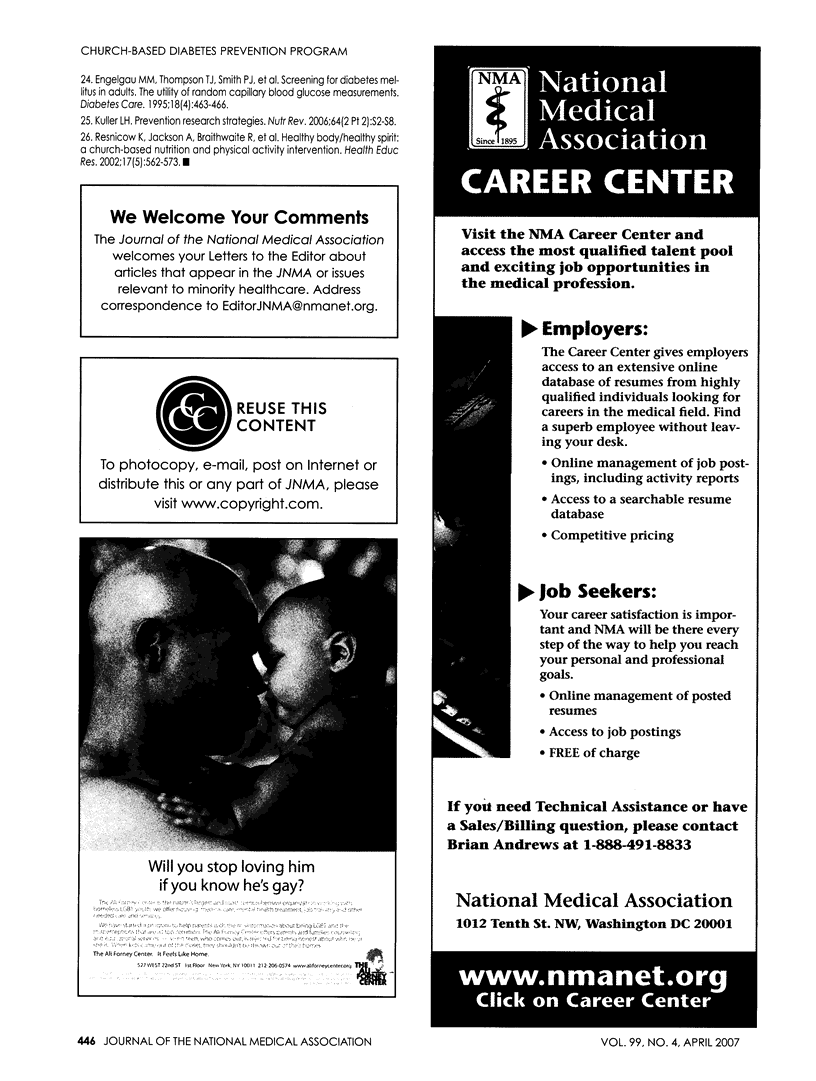
Selected References
These references are in PubMed. This may not be the complete list of references from this article.
- American Diabetes Association Screening for type 2 diabetes. Diabetes Care. 2000 Jan;23 (Suppl 1):S20–S23. [PubMed] [Google Scholar]
- Andersson Camilla M., Bjärås Gunilla E. M., Ostenson Claes-Göran. A stage model for assessing a community-based diabetes prevention program in Sweden. Health Promot Int. 2002 Dec;17(4):317–327. doi: 10.1093/heapro/17.4.317. [DOI] [PubMed] [Google Scholar]
- Benjamin Stephanie M., Valdez Rodolfo, Geiss Linda S., Rolka Deborah B., Narayan K. M. Venkat. Estimated number of adults with prediabetes in the US in 2000: opportunities for prevention. Diabetes Care. 2003 Mar;26(3):645–649. doi: 10.2337/diacare.26.3.645. [DOI] [PubMed] [Google Scholar]
- Boltri John M., Okosun Ike S., Davis-Smith Monique, Vogel Robert L. Hemoglobin A1c levels in diagnosed and undiagnosed black, Hispanic, and white persons with diabetes: results from NHANES 1999-2000. Ethn Dis. 2005 Autumn;15(4):562–567. [PubMed] [Google Scholar]
- Campbell M. K., Demark-Wahnefried W., Symons M., Kalsbeek W. D., Dodds J., Cowan A., Jackson B., Motsinger B., Hoben K., Lashley J. Fruit and vegetable consumption and prevention of cancer: the Black Churches United for Better Health project. Am J Public Health. 1999 Sep;89(9):1390–1396. doi: 10.2105/ajph.89.9.1390. [DOI] [PMC free article] [PubMed] [Google Scholar]
- Davis D. T., Bustamante A., Brown C. P., Wolde-Tsadik G., Savage E. W., Cheng X., Howland L. The urban church and cancer control: a source of social influence in minority communities. Public Health Rep. 1994 Jul-Aug;109(4):500–506. [PMC free article] [PubMed] [Google Scholar]
- Engelgau M. M., Narayan K. M. Finding undiagnosed type 2 diabetes: is it worth the effort? Eff Clin Pract. 2001 Nov-Dec;4(6):281–283. [PubMed] [Google Scholar]
- Engelgau M. M., Thompson T. J., Smith P. J., Herman W. H., Aubert R. E., Gunter E. W., Wetterhall S. F., Sous E. S., Ali M. A. Screening for diabetes mellitus in adults. The utility of random capillary blood glucose measurements. Diabetes Care. 1995 Apr;18(4):463–466. doi: 10.2337/diacare.18.4.463. [DOI] [PubMed] [Google Scholar]
- Fisher Edwin B., Walker Elizabeth A., Bostrom Ann, Fischhoff Baruch, Haire-Joshu Debra, Johnson Suzanne Bennett. Behavioral science research in the prevention of diabetes : status and opportunities. Diabetes Care. 2002 Mar;25(3):599–606. doi: 10.2337/diacare.25.3.599. [DOI] [PubMed] [Google Scholar]
- Glasgow Russell E. Translating research to practice: lessons learned, areas for improvement, and future directions. Diabetes Care. 2003 Aug;26(8):2451–2456. doi: 10.2337/diacare.26.8.2451. [DOI] [PubMed] [Google Scholar]
- Harris M. I., Flegal K. M., Cowie C. C., Eberhardt M. S., Goldstein D. E., Little R. R., Wiedmeyer H. M., Byrd-Holt D. D. Prevalence of diabetes, impaired fasting glucose, and impaired glucose tolerance in U.S. adults. The Third National Health and Nutrition Examination Survey, 1988-1994. Diabetes Care. 1998 Apr;21(4):518–524. doi: 10.2337/diacare.21.4.518. [DOI] [PubMed] [Google Scholar]
- Hoyo Cathrine, Reid Laverne, Hatch John, Sellers Denethia B., Ellison Arlinda, Hackney Tara, Porterfield Deborah, Page Joyce, Parrish Theodore. Program prioritization to control chronic diseases in African-American faith-based communities. J Natl Med Assoc. 2004 Apr;96(4):524–532. [PMC free article] [PubMed] [Google Scholar]
- King H., Aubert R. E., Herman W. H. Global burden of diabetes, 1995-2025: prevalence, numerical estimates, and projections. Diabetes Care. 1998 Sep;21(9):1414–1431. doi: 10.2337/diacare.21.9.1414. [DOI] [PubMed] [Google Scholar]
- Knowler William C., Barrett-Connor Elizabeth, Fowler Sarah E., Hamman Richard F., Lachin John M., Walker Elizabeth A., Nathan David M., Diabetes Prevention Program Research Group Reduction in the incidence of type 2 diabetes with lifestyle intervention or metformin. N Engl J Med. 2002 Feb 7;346(6):393–403. doi: 10.1056/NEJMoa012512. [DOI] [PMC free article] [PubMed] [Google Scholar]
- Kuller Lewis H. Prevention research strategies. Nutr Rev. 2006 Feb;64(2 Pt 2):S2–S8. doi: 10.1111/j.1753-4887.2006.tb00231.x. [DOI] [PubMed] [Google Scholar]
- Levin J. S. The role of the black church in community medicine. J Natl Med Assoc. 1984 May;76(5):477–483. [PMC free article] [PubMed] [Google Scholar]
- McNabb W., Quinn M., Kerver J., Cook S., Karrison T. The PATHWAYS church-based weight loss program for urban African-American women at risk for diabetes. Diabetes Care. 1997 Oct;20(10):1518–1523. doi: 10.2337/diacare.20.10.1518. [DOI] [PubMed] [Google Scholar]
- Oexmann M. J., Ascanio R., Egan B. M. Efficacy of a church-based intervention on cardiovascular risk reduction. Ethn Dis. 2001 Fall;11(4):817–822. [PubMed] [Google Scholar]
- Pepe Connie. Diabetes prevention program strategies and tools could be translated to practice setting. J Am Diet Assoc. 2006 May;106(5):705–708. doi: 10.1016/j.jada.2006.02.016. [DOI] [PubMed] [Google Scholar]
- Resnicow Ken, Campbell Marci Kramish, Carr Carol, McCarty Frances, Wang Terry, Periasamy Santhi, Rahotep Simone, Doyle Colleen, Williams Alexis, Stables Gloria. Body and soul. A dietary intervention conducted through African-American churches. Am J Prev Med. 2004 Aug;27(2):97–105. doi: 10.1016/j.amepre.2004.04.009. [DOI] [PubMed] [Google Scholar]
- Resnicow Ken, Jackson Alice, Braithwaite Ronald, DiIorio Colleen, Blisset Dhana, Rahotep Simone, Periasamy Santhi. Healthy Body/Healthy Spirit: a church-based nutrition and physical activity intervention. Health Educ Res. 2002 Oct;17(5):562–573. doi: 10.1093/her/17.5.562. [DOI] [PubMed] [Google Scholar]
- Tuomilehto J., Lindström J., Eriksson J. G., Valle T. T., Hämäläinen H., Ilanne-Parikka P., Keinänen-Kiukaanniemi S., Laakso M., Louheranta A., Rastas M. Prevention of type 2 diabetes mellitus by changes in lifestyle among subjects with impaired glucose tolerance. N Engl J Med. 2001 May 3;344(18):1343–1350. doi: 10.1056/NEJM200105033441801. [DOI] [PubMed] [Google Scholar]
- Zimmet P., Shaw J., Alberti K. G. M. M. Preventing Type 2 diabetes and the dysmetabolic syndrome in the real world: a realistic view. Diabet Med. 2003 Sep;20(9):693–702. doi: 10.1046/j.1464-5491.2003.01052.x. [DOI] [PubMed] [Google Scholar]


